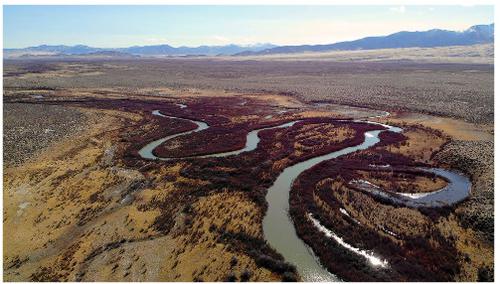当前位置:
X-MOL 学术
›
Earth Surf.Process. Land.
›
论文详情
Our official English website, www.x-mol.net, welcomes your feedback! (Note: you will need to create a separate account there.)
Planform‐asymmetry and backwater effects on river‐cutoff kinematics and clustering
Earth Surface Processes and Landforms ( IF 3.3 ) Pub Date : 2020-10-30 , DOI: 10.1002/esp.5029 Alessandro Ielpi 1, 2 , Mathieu G.A. Lapôtre 3 , Alvise Finotello 4, 5 , Massimiliano Ghinassi 5
Earth Surface Processes and Landforms ( IF 3.3 ) Pub Date : 2020-10-30 , DOI: 10.1002/esp.5029 Alessandro Ielpi 1, 2 , Mathieu G.A. Lapôtre 3 , Alvise Finotello 4, 5 , Massimiliano Ghinassi 5
Affiliation

|
River bends occasionally meander to the point of cutoff, whereby a river shortcuts itself and isolates a portion of its course. This fundamental process fingerprints a river's long‐term planform geometry, its stratigraphic record, and biogeochemical fluxes in the floodplain. Although meander cutoffs are common in fast‐migrating channels, timelapse imagery of the Earth surface typically does not offer a long enough baseline for statistically robust analyses of these processes. We seek to bridge this gap by quantifying cutoff kinematics along the Humboldt River (Nevada) – a stream that, from 1994 to 2019, hosted an exceptionally high number of cutoffs (specifically, 174 of the chute type and 53 of the neck type). A coincidence between major floods and cutoff incidence is first suggestive of hydrographic modulation. Moreover, not just higher sinuosity but also upstream planform skewness is associated with higher cutoff incidence and channel widening for a sub‐population of chute cutoffs. We propose a conceptual model to explain our results in terms of channel‐flow structure and then examine the distances between adjacent cutoffs to understand the mechanisms governing their clustering. We find that both local and nonlocal perturbations together trigger the clustering of new cutoffs, over distances capped by the backwater length and over yearly to decadal timescales. Our research suggests that planform geometry and backwater controls might sway the occurrence of cutoff clusters – both local and nonlocal – thereby offering new testable hypotheses to explore the evolution of meandering‐river landscapes that have significant implications for river engineering and stratigraphic modelling. © 2020 John Wiley & Sons, Ltd.
中文翻译:

平面非对称性和回水对截流运动学和聚类的影响
河流有时会弯曲到截止点,河流会因此自身短路并隔离其一部分路线。这个基本过程为河流的长期平面几何形状,地层记录以及洪泛区中的生物地球化学通量提供了指纹。尽管在快速迁移的通道中常见曲折截止点,但地球表面的延时成像通常无法提供足够长的基线来进行这些过程的统计分析。我们试图通过量化洪堡河(内华达州)的截断运动学来弥合这一差距,该流在1994年至2019年间拥有大量截断(特别是斜道类型174和颈部类型53)。大洪水与截流发生率之间的巧合首先暗示了水文调制。而且,不仅较高的弯曲度,而且上游平台的偏斜度也与较高的截止发生率和通道扩展有关,这是斜道截止的一部分。我们提出了一个概念模型,以通道流结构来解释我们的结果,然后检查相邻边界之间的距离,以了解控制其聚类的机制。我们发现,局部和非局部扰动共同触发了新的截止点的聚类,这些截止点的范围超过了死水长度,并且每年超过十年。我们的研究表明,平面几何形状和回水控制可能会影响局部和非局部截断团簇的发生,从而提供新的可检验假说,以探索对河流工程和地层建模具有重要意义的曲折河道景观的演变。分级为4 +©2020 John Wiley&Sons,Ltd.
更新日期:2020-10-30
中文翻译:

平面非对称性和回水对截流运动学和聚类的影响
河流有时会弯曲到截止点,河流会因此自身短路并隔离其一部分路线。这个基本过程为河流的长期平面几何形状,地层记录以及洪泛区中的生物地球化学通量提供了指纹。尽管在快速迁移的通道中常见曲折截止点,但地球表面的延时成像通常无法提供足够长的基线来进行这些过程的统计分析。我们试图通过量化洪堡河(内华达州)的截断运动学来弥合这一差距,该流在1994年至2019年间拥有大量截断(特别是斜道类型174和颈部类型53)。大洪水与截流发生率之间的巧合首先暗示了水文调制。而且,不仅较高的弯曲度,而且上游平台的偏斜度也与较高的截止发生率和通道扩展有关,这是斜道截止的一部分。我们提出了一个概念模型,以通道流结构来解释我们的结果,然后检查相邻边界之间的距离,以了解控制其聚类的机制。我们发现,局部和非局部扰动共同触发了新的截止点的聚类,这些截止点的范围超过了死水长度,并且每年超过十年。我们的研究表明,平面几何形状和回水控制可能会影响局部和非局部截断团簇的发生,从而提供新的可检验假说,以探索对河流工程和地层建模具有重要意义的曲折河道景观的演变。分级为4 +©2020 John Wiley&Sons,Ltd.


























 京公网安备 11010802027423号
京公网安备 11010802027423号